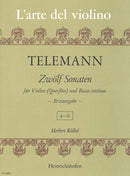| 作曲者 | Georg Philipp Telemann (1681-1767)・ゲオルク・フィリップ・テレマン |
| タイトル | Zwölf Sonaten, vol. 2 (4-6) |
| サブタイトル | Serie: L'arte del violino |
| 出版社 | Heinrichshofen Verlag |
| 楽器編成 | violin (fl) and basso continuo |
| 品番 | mds9790204413287 |
| 校訂者 | Herbert Koelbel |
| 難易度 | easy - intermediate |
| 形状 | 44 ページ・23.0 x 30.5 cm・280 g |
| 出版番号 | N 1328A |
| ISMN | 979-0-2044-1328-7 |
| サンプル | http://assets.schott-music.com/Assets/Product/0/72/6/720682/500_MAVE/BSPSEITEN/HEIN_1328-01-01.jpg:: |
This edition is based on a manuscript from the Staatsbibliothek Berlin, Preußischer Kulturbesitz, Musikabteilung. It comes from the estate of Telemann, who gave it to his grandson Georg Michael Telemann (1748-1831). G. Poelchau acquired the manuscript in 1834 with a pack of music stored in a church tower in Riga. From Poelchau's estate († 1836) the sonata work came to the Königliche Bibliothek in Berlin. The sonatas are dedicated to the brothers of a Hamburg patrician family Rudolf, Hieronymus and Johannes Wilhelm Burmester with the date March 1, 1734, with the note that they follow the «12 methodical sonatas », which were also dedicated to the first two brothers mentioned.
The close connection between the two large sonata works is evident in their high musical content, in their structure with the sequence of movements (slow, fast, slow, fast) and in the way they run through the keys (C-a-D-h-E-F-d-G-e-A-f#-g). The bass lines are often involved in the theme. Some of the music is reminiscent of J.S. Bach's inventions. In the title, the violin is named as the solo instrument before the flute, as several sonatas are unmistakably written for violin without this hindering their playability for flute. The present edition adheres strictly to the manuscript. Suggestions for dynamics are indicated as such by brackets, as are those for articulation (by dashes), which may differ for violinists from those intended for flute players.
Experienced players should use the original figuring for their own arrangement of the basso continuo. The 12 sonatas published here for the first time are among the best compositions of this kind by Telemann, who dedicated them to «connoisseurs and lovers» with the wish «...faire une bonne partie de Vos amusements». The sonatas will fulfill this purpose just as well today as they did at the time.
IV.
Largo
Allegro
Andante
Vivace
V.
Largo
Allegro
Grave
Vivace
VI.
Andante
Presto
Cantabile
Vivace



